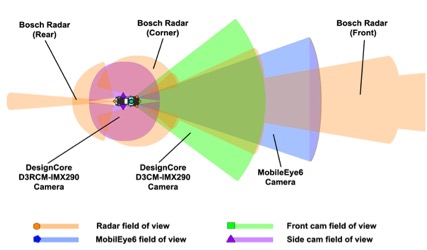Research and Field-Testing of Vehicle-Traffic Control with Limited-Capacity Connected/Autonomous Vehicles
Overview
Connected and automated vehicles (CAVs) are believed to have great promise for the future of urban traffic control, and much research has been conducted in the past decade on the possibilities CAVs present for improving traffic flow in cities. However, the primary focus has been on fully automated vehicles and environments with 100% connected and automated vehicles, which is not expected to become reality for a relatively long time. In the near future, urban environments are likely to have low concentrations of CAVs and limited levels of autonomy (LCAVs). Furthermore, field-testing of CAV-based traffic control methods, especially with LCAVs, is lacking. Understanding and field-testing the benefits of traffic control with LCAVs is an imperative question for the near-term.
Prior research undertaken by this team has focused on developing integrative vehicle-traffic control (iVTC) methods in environments with fully automated and connected vehicles. This project aims to extend and field-test CAV-based traffic signal/vehicle control methods developed by the research team in previous projects to understand and quantify the benefits of CAV-based control in the real world.
Research Objectives & Deliverables
This project will extend and redevelop the team’s CAV-based traffic-vehicle control methods developed in earlier projects to accommodate LCAVs and test the methods in real-world settings. The research team plans to field-test and evaluate the benefits of vehicle control with LCAVs both for equipped vehicles and all vehicles in the traffic system. To achieve these objectives, the team is collaborating with the EcoCar3 team at UW, as well as researchers and experts at other partner universities.
The deliverables for this project include:
- Vehicle-traffic control methods and algorithms designed for environments with limited autonomy CAVs
- An interim report on field testing of CAV equipped vehicles
- An interim report on field testing and simulation of IVTC with LCAVs

Personnel
| Principal Investigator | Xuegang (Jeff) Ban, UW |
| Funding Source | C2SMART Center: $102,500 UW: $55,000 |
| Total Project Cost | $157,500 |
| USDOT Award # | 69A3551747124 |
| Start and End Dates | 03/01/2019-07/31/2020 |
| Implementation of Research Outcomes | Research and field testing of CAV-based traffic/vehicle control; vehicle in the loop simulation |
| Impacts/Benefits of Implementation | Understanding benefits of CAVs with limited penetration and autonomy |









